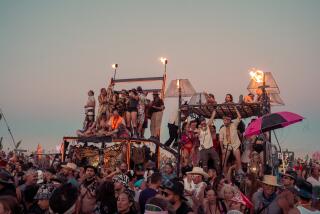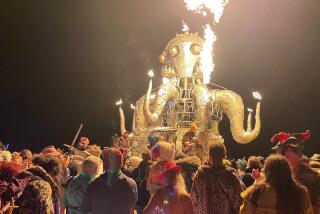Scenes from that fiery festival
ON the morning after this review hits the paper, some 40,000 people will be waking up in their tents and domes and recreational vehicles on the inhospitable alkaline soil of a prehistoric lake bed in northern Nevada. They will blow their bloody noses clear of dust, they will rub balm on their cracking feet, and they will stumble, most of them at least half naked, to a row of fetid portable toilets a few hundred feet away from where they slept.
They will fire up their propane stoves for coffee, brush silt off their wind-battered folding chairs and watch the dirty parade of striped knee-highs and stilts and neon wigs. And they will realize, many of them, that they have never been happier in their lives.
It has been said that describing the Burning Man Festival to the uninitiated is a little like describing a color to a blind person. I think it’s more like describing a color to someone who’s colorblind but just won’t admit it. The person imagines that the city rising in the Black Rock Desert the week before Labor Day (the festival runs today through Sept. 3) fits into some preconfigured idea: It’s Woodstock or a Grateful Dead show or an acid trip in Malibu, 20 years back.
If you’ve been to Black Rock, you try to correct these people, stammering defensively about generosity and cool art and dressing up in a jeweled cocktail dress to ride your bike across the “playa,” as geologists call this flat expanse. You tell them about that one dark morning in 1999 when you mistook the rising moon for someone’s art. You insist you weren’t on drugs.
Now, thanks to Jessica Bruder, a reporter for the Oregonian, you can simply hand these people “Burning Book: A Visual History of Burning Man” and let them come up with their own descriptions. Of all the books, films and YouTube videos that have attempted to interpret Burning Man for the “default” world, Bruder’s project is among the few that allows you to plant yourself at the scene and wallow in it, with your faculties and filters unclouded by an author’s personal agenda.
Bruder writes little about herself in “Burning Book,” although her personal website reveals her as a frequent playa visitor who has done time in Paris and New York (she was once a staff writer for the New York Observer). But instead of venting all her wild times in her book, she does something monumental: She reports the story.
That doesn’t mean “Burning Book” is dry; not at all. Bruder crafts quietly poetic accounts of “the area known to its inhabitants as Black Rock City . . . [this] place that writer Stephen Black once called, with admirable precision, an ‘Ephemeropolis.’ ” She writes accessibly enough that readers who have never even heard of the festival can live vicariously in these pages; she writes with enough authority that die-hard “Burners” will feel fairly represented by her claims.
With the help of 38 photographers, she digs deep into Burning Man’s history. Even if you think you know it all, you will learn something here.
The Burning Man Festival began almost accidentally in 1986, when landscape gardener Larry Harvey burned an 8-foot wooden effigy on San Francisco’s Baker Beach. The first effigy “was a rudimentary human figure, all hips and elbows,” writes Bruder, who bases her account on scores of interviews with the event’s architects and longtime participants.
Depending on who’s talking -- or on which day the now-59-year-old Harvey is talking -- Harvey was either grieving a romance, paying homage to his father or just fooling around. “Burning Man is not outlined like a murder mystery,” Bruder reminds us. Somehow, the burn became an annual party that in four years grew to 800 revelers with an effigy so big it had to be brought in pieces. Predictably, the police deemed the event a hazard, and in 1990, they ordered it off the beach. But the San Francisco Cacophony Society, a self-described “network of free spirits united in the pursuit of experiences beyond the pale of mainstream society,” came up with a plan: They would haul Harvey’s wooden man to a desert just north of Gerlach, Nev., “a wide, seemingly invisible place where nobody would care how they carried on.” And on Labor Day weekend, 1990, Black Rock City was born.
Bruder has compiled much precious ephemera from these early days and beyond: newsletters, stickers, buttons, homemade medallions and tickets; she has also included years’ worth of Black Rock City maps and covers of the familiar playa newspaper, “Piss Clear” (a reminder for participants to drink water). The book has the quality of an assiduously compiled scrapbook, a testament to so much of the smart creativity that comes to the event, and also to the expansiveness that rules in this “gift economy.” It’s a little-known truth: People on the playa are astonishingly nice.
“A dozen people were hanging around Diva Boot Camp when they heard New Orleans was gone,” Bruder writes of the 2005 festival, taking place as Hurricane Katrina hit the Gulf Coast. That year, Joan Baez sang in honor of the victims; camps collected food and supplies to send down South. And in the aftermath, a group of participants headed to Mississippi and Louisiana to share knowledge and manpower. It was the beginning of a new collective, “Burners Without Borders,” that led to 2007’s environmentally conscious theme, “The Green Man.”
“Larry Harvey,” says Bruder, “wants Burning Man to become a movement.” Will it work? Bruder, neither seduced nor suspicious, doesn’t judge. “After two decades people still care deeply about the strange metropolis they’ve created,” she concludes. “Even if they can’t agree on what it is, or what it means, or if they should bother to define it at all.” Wisely, Bruder has written a book that won’t help with intellectual definitions. She has written a book that goes to the heart. As it should.
Judith Lewis is a staff writer for LA Weekly.
More to Read
The biggest entertainment stories
Get our big stories about Hollywood, film, television, music, arts, culture and more right in your inbox as soon as they publish.
You may occasionally receive promotional content from the Los Angeles Times.










